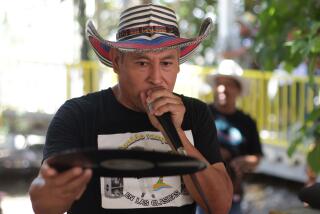Land-Sharing Idea Offers Impoverished Filipinos Hope
- Share via
Of all the problems of poverty in the Philippines, no single one is greater than that of sugar-cane workers on the island of Negros. Work, which brings 50 cents to $1.50 a day, is virtually unavailable during the five-month “dead season” that begins in June, after the cane is harvested. With the world price of sugar under 7 cents a pound, an estimated 80% of the plantations are so deeply in debt (despite the low wages) as to be foreclosable, yet there is little diversification into other crops. And, amid the poverty and hunger, the communist New People’s Army is highly active.
The first great test of whether the Aquino government can deal with the country’s accumulated economic and political problems may well come on Negros, and one small reason for hope is that a model for plantations has been developed there to deal with the problem.
On about 30 haciendas, owners have entered voluntary land-sharing schemes under which an average of about 10% of the plantation’s land--land of good quality--is redistributed in small plots or tiny cooperatives to the laborers, usually for a moderate price that is payable on easy terms. The land rights have been combined with a very modest amount of credit, inputs and agricultural advice.
On these garden plots, small agricultural miracles have been taking place: Dozens of crops (no sugar cane) are proliferating, with a quarter-acre of irrigated land sometimes producing enough rice to feed a family of six for a year. In place of the “dead season” is an opportunity to utilize the family’s labor year round. A model for crop diversification also is being created, which offers further hope of year-round work. Not surprisingly, there is evidence that the NPA has been virtually frozen out on these plantations.
Interestingly, there appears to be convergence of some very different groups toward support of such land sharing--among them the progressive planters, the most militant of the agricultural workers’ groups (which calls for 20% of the land) and even the NPA (which calls for “at least 10%”). The workers would continue to work on the plantations but would supplement their incomes and nutrition with the produce of the redistributed land.
The problem lies in rapid expansion of the program. For most planters, something close to market land prices will have to be paid, and the government has few resources. To spread the scheme throughout Negros would require redistributing 50,000 to 60,000 acres, worth $40 million to $50 million. To extend it to all sugar cane-producing areas, and to benefit perhaps a quarter-million of the country’s poorest families, would involve 100,000 to 120,000 acres worth up to $100 million.
Several ideas have been suggested for funding, such as earmarking an increment to U.S. aid to the Philippines. One intriguing option, suggested by the new governor of Negros, is a temporary reallocation of a part of the U.S. sugar quota to the Philippines, to be used principally to finance land sharing nationwide. The U.S. sugar price is roughly 21 cents a pound, three times the world price, but only countries with a “quota” under a 1982 act can export sugar to the United States.
A doubling of the Philippine quota would transfer enough resources to finance a 10% land-sharing scheme countrywide in less than two years--the added quota could simply be allocated to plantations that choose to transfer 10% of their prime land to their workers. Under the circumstances, our impression is that virtually all planters would do so. (By contrast, an increase in the quota not linked to land sharing is likely neither to benefit the farm laborers nor to promote diversification.)
While a reallocation of quotas would carry no financial costs to the United States, other countries’ quotas would have to be reduced. A start has already been made in the Senate sanctions bill transferring South Africa’s quota to the Philippines, but there is still a need for the Philippine government to commit this resource to land sharing. There are two further options: A much larger part of the resources needed could come from the quotas of developed countries such as Australia and Canada, thus treating sugar quotas as a kind of “foreign aid,” or more could come from the quotas of countries that are net importers of sugar--countries that in effect buy sugar on the world market at 7 cents a pound and resell it to us at 21 cents to fill their “quota.” This includes Canada, as well as Peru, India, Ecuador and Mozambique. Surely the quota was never intended to benefit such importing countries.
What is most needed now is a simple announcement by the Aquino government that it wants an increase in the quota to allow land to be transferred to a quarter-million families of cane workers who are among the most impoverished people in the Philippines.
More to Read
Sign up for Essential California
The most important California stories and recommendations in your inbox every morning.
You may occasionally receive promotional content from the Los Angeles Times.










